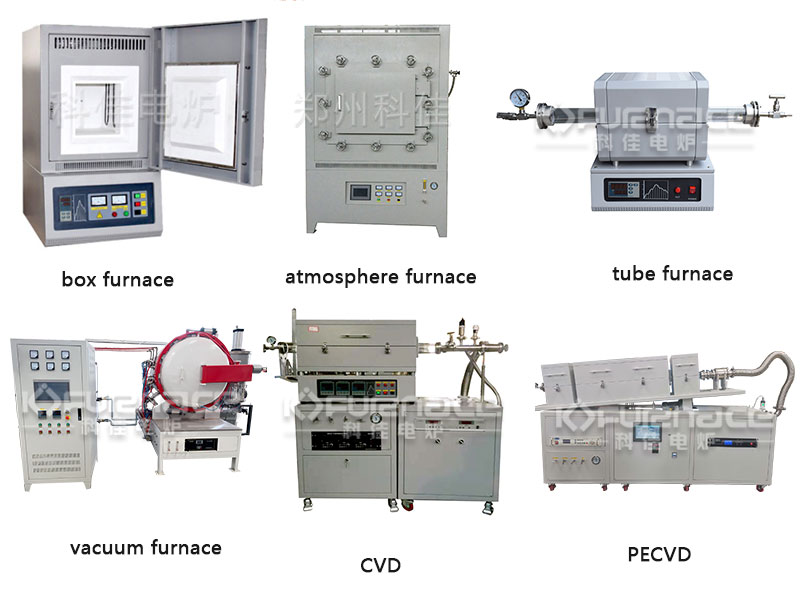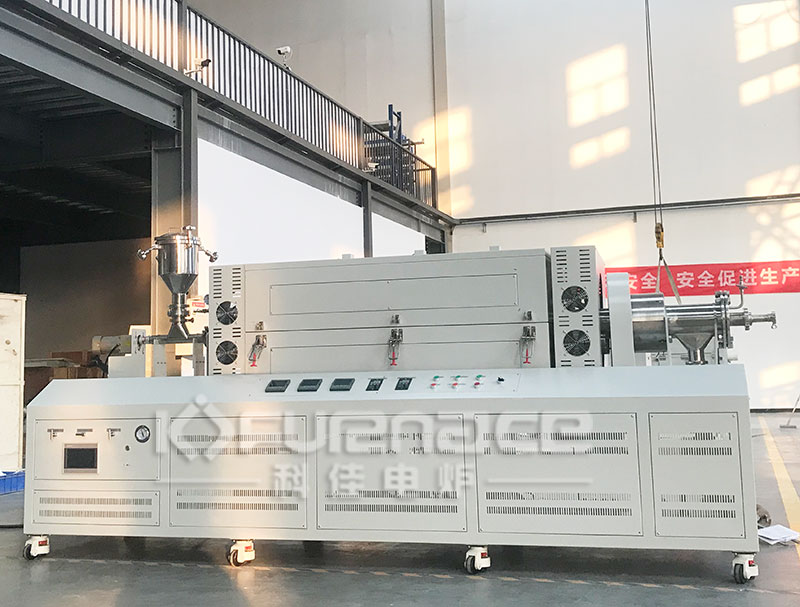The selection of a heat treatment furnace usually depends on the required heat treatment process and materials. Different types of heat treatment furnaces are suitable for different applications. There are many types of heat treatment furnaces, such as box furnaces, atmosphere furnaces, tube furnaces, vacuum furnaces, CVD, PECVD, etc. Choosing a furnace that is more suitable for one’s own heat treatment process is essential to be more proficient in material processing. Below, we will introduce to you the types of heat treatment furnaces and the corresponding heat treatment methods for each furnace type.
1. Heat treatment furnaces can be divided into:
① Quenching furnace: used for quenching metals to improve their hardness and strength. Quenching furnaces typically use media such as gas, oil, or water for quenching.
② Tempering furnace: used to temper quenched metals to adjust their hardness and improve their toughness.
③ Annealing furnace: used to reduce metal hardness and improve machinability. Annealing furnaces are usually achieved by controlling temperature and holding time.
④ Soaking furnace: used to heat metals to a uniform temperature for other heat treatment operations, such as quenching, tempering, etc.
⑤ Vacuum furnace: provides an oxygen free or low oxygen environment, suitable for precision heat treatment of metals, avoiding oxidation or other surface reactions.
⑥ Atmosphere furnace: provides a specific atmosphere environment, such as hydrogen, nitrogen, etc., to affect the surface chemical properties of metals.
⑦ Heat treatment line: a production line that automatically and continuously performs heat treatment for large-scale production.
⑧ Box furnace: Closed furnace body, suitable for small batch production or laboratory applications.
⑨ Horizontal and vertical furnaces: suitable for workpieces of different shapes and sizes, and can be selected according to specific needs.
2、 Heat treatment furnaces can be divided into:
① Box type furnace: There are large and small classifications. Small types can be used for experiments, ashing, composition detection, annealing, tempering, sintering, etc. Large types can be used for industrial trolley furnaces, metal material sintering, large material annealing, tempering, etc. Box type furnaces are mainly used in powder, electronics, metallurgy, medicine, ceramics, glass new materials, chemical industry, metal sintering, and metal heat treatment.

Heat treatment furnaces can be divided into the following types based on furnace type
② Atmosphere furnace: Gas can be introduced into the furnace body on the basis of a box furnace to ensure material reaction, or heat treatment of materials in a vacuum state. Atmosphere furnaces are mainly used in the pre firing, sintering, brazing and other processes of electronic ceramic products in metallurgy, machinery, light industry, commercial inspection, higher education institutions and scientific research departments, and industrial and mining enterprises.
③ Tube type furnace: The heating furnace is a tube type furnace, and the furnace material of a tube type furnace is generally: metal stainless steel tube, quartz tube, mullite tube, aluminum oxide tube (also known as corundum tube), etc. Different pipes have different heating temperatures and prices. Choosing a suitable pipe type for your own heat treatment process is more suitable. Tube furnace is mainly used in laboratory calcination and drying of positive electrode materials for batteries, non strong acid-base powder materials, and granular materials, as well as in the growth of graphene in universities, research institutes, and industrial and mining enterprises, high-temperature atmosphere sintering, atmosphere reduction, CVD experiments, and other scenarios. It is a widely used heat treatment furnace type.

Large rotary tube furnace is the most commonly used type of tube furnace (click on the image to view product details)
④ Vacuum furnace: Generally, a vacuum heat treatment furnace is mainly composed of a vacuum furnace body, a heating furnace, a temperature measurement system, a vacuum system, a manufacturing system, a water cooling system, etc. The furnace can pump high vacuum or pass gas, which has better vacuum degree and sealing than other furnace types. It is suitable for heat treatment processes that require higher vacuum degree or gas tightness. The main application scenarios of vacuum furnaces are high-temperature hot forming of new materials such as powder metallurgy, functional ceramics, silicon carbide, alumina, etc. It is mainly suitable for bright annealing after quenching of materials such as high-speed steel, mold steel, tool steel, alloy steel, titanium alloy, etc. Eliminating residual internal stresses in forgings, welded parts, cold stamped parts, and quenched workpieces, preventing deformation and cracking of workpieces, vacuum brazing of high-temperature alloys, hard alloys, ceramics, and vacuum sintering of rare earth permanent magnet alloys, carbides, metal ceramics, and other powder materials.
⑤ CVD system: CVD system is a method of adding a gas mixing system on the basis of a tube furnace, which uses gaseous or vapor chemical substances to deposit solid deposits on the gas phase or gas-solid interface through chemical reactions. The CVD system is mainly applied in the preparation of single crystal, polycrystalline or amorphous materials of various materials, including silicon, carbides, nitrides, oxides, etc. These materials can be used to manufacture integrated circuits, electronic devices, optical devices, sensors, etc. It is a technology widely used in the preparation of thin films, coatings, and materials.
⑥ PECVD system: The PECVD system adds a plasma radio frequency system on the basis of the CVD system, which is a technology that rapidly conducts chemical reactions at lower temperatures. It uses plasma energy to chemically react gaseous or vapor state chemicals in the reactor to form solid deposits at the gas-phase or gas-solid interface. It activates chemical reactions by introducing plasma into the reaction chamber, utilizing the energy of the plasma to quickly deposit the required thin film at lower temperatures. The PECVD system can perform material coating at lower temperatures than the CVD system. The main applications of PECVD system: used for preparing thin films such as silicon oxide and silicon nitride, and for manufacturing semiconductor devices such as transistors and integrated circuits; Preparation of transparent conductive films, zinc oxide films, etc., widely used in the production of liquid crystal displays (LCDs) and organic light-emitting diodes (OLEDs); Amorphous silicon and silicon nitride, used for the preparation of solar cells; Reflective film, anti reflective film, etc., applied to coatings of optical components; Prepare protective films such as scratch resistant, waterproof, and corrosion-resistant coatings.

The most commonly used PECVD system (click on the image to view product details)
The selection of a heat treatment furnace also involves factors such as temperature range, heating method, and control system. When selecting a heat treatment furnace, it is necessary to consider the required process specifications and material properties to ensure that the selected furnace type meets specific heat treatment requirements. Click to learn more about heat treatment equipment! Or click to consult online customer service to choose the furnace type suitable for your own heat treatment process!